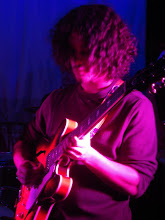What follows below are 3 sheets of paper, one compiled by Mick Goodrick and the other compiled by me for a piano player. They both address the issue of how to come up with new voicings to freshen up your playing. Perhaps the global lesson of all Mick Goodrick's Almanacs is that before even picking up your guitar it can help to lay out a theoretical road map of all the possibilities for whatever you're going to work on. The reason for this is that once you start working, you very quickly get bogged down with possibilities. If you're trying to learn them all you'll never get to the end of the list.
It's much less exhausting to think about the all the possibilities first and write them out then to have to play them all. Suppose that you're trying to learn drop 2&4 voicings. Suppose you decide to go through all the chord types, maj7, then min7 etc. It becomes overwhelming to have to think of all the possibilities and put yourself under the immense pressure to both remember and learn them all on your guitar. So probably you will never get to the vast majority of the mathematical and technically feasible possibilities. But if you make a list, you can hop around.
Take a look at Mick's list below. Mick is trying to come up with minor II V voicings, so he makes a chart. He wants to use the 6th mode of melodic minor for Em7b5 and the altered scale for A7. So he writes out every possible four note chord voicing from the five categories of chords which exist in the mode and he circles all the ones that don't have the note E in them. He's decided that he wants to use rootless voicings. He could have decided otherwise.
Now imagine if you were trying to think of all that while you were also trying to play them on guitar? It's confusing and hard to keep track of everything. Did I do that one yet? What was that last one? This way you can jump around from circle to circle without constantly having to recalculate that information and then see if you find anything you like on the guitar. Having a systematic (maybe even scientific) coding system before you start practising allows for a much less systematic and generally more inspiring and productive practice method.
Then we see all the four note possibilities for the A7. Again, because all the possibilities are mapped out, this frees up a great amount of our imagination and concentration while practising to look for musical and emotional possibilities rather than just systematically running through the list. We can never learn all the possibilities so why even try? But we can reduce them to one handwritten 8.5x11 page. And then just go wherever we are interested in going at that very moment.
I cannot stress enough: without writing out that page, it becomes necessary to memorize it without ever even seeing it, and probably you will be trying to play them at the same time as think of them. For those familiar with the juggling act, this is a few too many balls even within a practice context.
Take a look at the pages I wrote. They essentially recycling the information from the Almanacs. It is just another way of presenting the information on Mick Goodrick's page. Since it is geared for a specific talented piano player who transposes and planes shapes modally quite effortlessly, you'll notice that I spend more time explaining the way voicings are constructed (drop 2 vs drop 3 etc) as opposed to Mick's page which assumes you already have done a lot of work exploring inversions and is more interested in the aspect of modal planing.
Either way, it is a good idea to write down everything that comes to you. You don't want to have to repeat the mental process to get back to it. Thinking is the important first step. But once you've thought your way somewhere interesting it is time to mindlessly memorize it on a totally non-intellectual level.
You'll notice that if you treat the G# minor scale as a vertical scale (and don't mind the crunch of the 5th and 6th occasionally), that any chord from the mode in any inversion and in any substitution (TBN, clusters etc) becomes a possible chord (at least for a few beats if it is extremely tense and feels like it needs to be resolved). You'll also notice at the bottom of the last page there is an equation which shows that there are AT LEAST (and probably more) 1176 easily playing voicings on the piano for a G#m7 chord in a modal context.
Working through them would be pointless. What if one of your all time future favourite voicings is number 1032? What if it's really not obvious to you? I would hate to have to play 1031 to find out what it is. That's why a good road map is essential. Or maybe it's more like the yellow pages. You know what you're looking for but you're not sure who exactly is going to give it to you. You look up the general area you require and then you dial a few numbers to find exactly the right thing you needed. Or, maybe, just maybe, it is indeed like an Almanac.
Subscribe to:
Post Comments (Atom)




No comments:
Post a Comment